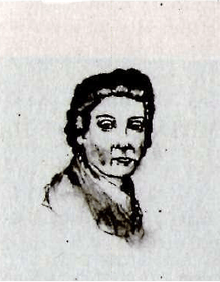Kamures Kadın
| Kamures Kadın | |
|---|---|
 | |
| Born |
5 March 1855 North Caucasus |
| Died |
30 April 1921 (aged 66) Istanbul, Ottoman Empire |
| Burial | Eyüp Cemetery |
| Spouse | Mehmed V |
| Issue | Şehzade Mehmed Ziyaeddin |
| Religion | Islam |
Kamures Kadın (5 March 1855 – 30 April 1921), meaning "Bringer of pleasure",[1] was the first wife of Sultan Mehmed V of the Ottoman Empire.[2]
Early life
Of Circassian origin, Kamures Kadın was born on 5 March 1855[3] in Caucasus. She belonged to the Ubykh clan of Circassia.[4]
Marriage
Kamures married Mehmed on 30 September 1872 in the Ortaköy Palace.[4] A year after the marriage, on 26 August 1873, she gave birth to her only son, Şehzade Mehmed Ziyaeddin.[5] On 27 April 1909, after Mehmed's accession to the throne,[6] she was given the title of "Baş Kadın".[2]
In 1912, the "Hilal-i Ahmer Centre for Women" was organized within the "Ottoman Hilal-i Ahmer Association", a foundation established in 1877 to provide medical care in Istanbul and surrounding communities.[7] Kamures served as the president of this organization.[8]
Safiye Ünüvar, a teacher at the Palace School, commented in her memoirs about her beauty, and said that she still some of her looks, when the two met in 1915.[9][10] Kamures had occupied herself with reading history, and whenever Safiye visited her she would always bring up with the subject of Ottoman history.[11]
In 1918, she met with the Tsar Boris III of Bulgaria, when he visited Istanbul.[4][12] On 18 May 1918, she also met with the Empress Zita of Bourbon-Parma in the harem of Dolmabahçe Palace, when the latter visited Istanbul.[13]
Death
After Mehmed's death on 3 July 1918,[14] she settled in the palace of Şehzade Mahmud Necmeddin in Kuruçeşme, where she died on 30 April 1921. She was buried in the mausoleum of her husband located in the Eyüp Cemetery, Istanbul.[8][9][10]
References
- ↑ Brookes 2010, p. 207 n. 7.
- 1 2 Uluçay 2011, p. 260.
- ↑ Brookes 2010, p. 283.
- 1 2 3 Açba 2007, p. 163.
- ↑ Brookes 2010, p. 291.
- ↑ Faroqhi, Suraiya (2008). The Cambridge History of Turkey. Cambridge University Press. p. 79. ISBN 978-0-521-62096-3.
- ↑ Hacker, Barton; Vining, Margaret (August 17, 2012). A Companion to Women's Military History. BRILL. p. 199. ISBN 978-9-004-21217-6.
- 1 2 Açba 2007, p. 164.
- 1 2 Brookes 2010, p. 207.
- 1 2 Sakaoğlu 2008, p. 701.
- ↑ Brookes 2010, p. 231.
- ↑ Sakaoğlu 2008, p. 700.
- ↑ Açba, Leyla (2004). Bir Çerkes prensesinin harem hatıraları. L & M. p. 56. ISBN 978-9-756-49131-7.
- ↑ Tucker, Spencer C. (October 28, 2014). World War I: The Definitive Encyclopedia and Document Collection [5 volumes]: The Definitive Encyclopedia and Document Collection. ABC-CLIO. p. 1071. ISBN 978-1-851-09965-8.
Sources
- Uluçay, M. Çağatay (2011). Padişahların kadınları ve kızları. Ötüken. ISBN 978-9-754-37840-5.
- Açba, Harun (2007). Kadın efendiler: 1839-1924. Profil. ISBN 978-9-759-96109-1.
- Sakaoğlu, Necdet (2008). Bu Mülkün Kadın Sultanları: Vâlide Sultanlar, Hâtunlar, Hasekiler, Kandınefendiler, Sultanefendiler. Oğlak Yayıncılık. ISBN 978-6-051-71079-2.
- The Concubine, the Princess, and the Teacher: Voices from the Ottoman Harem. University of Texas Press. 2010. ISBN 978-0-292-78335-5.
